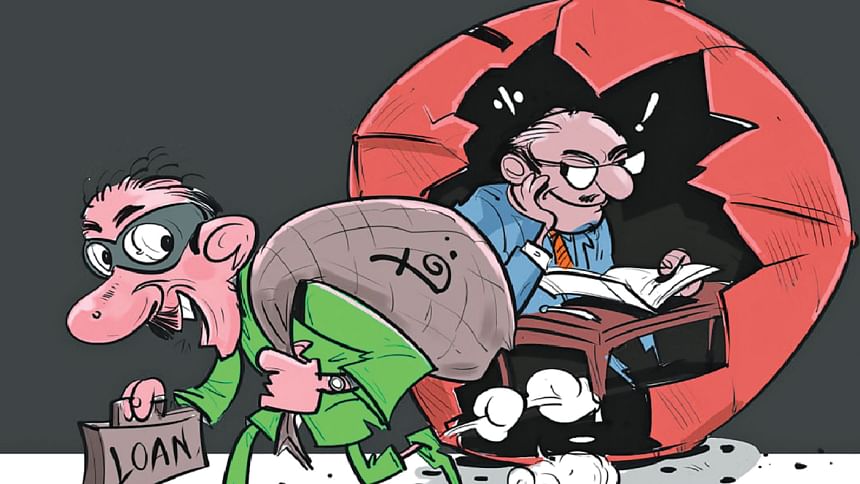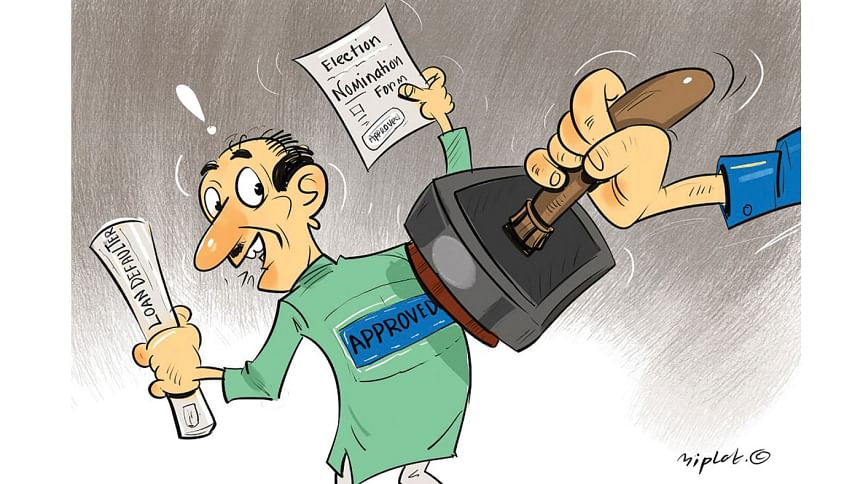How default culture plagues Bangladesh’s banking sector

A pre-Socratic Greek philosopher named Parmenides first articulated the famous idea: "Nothing comes from nothing." Later, it appeared in Aristotle's Physics. The Roman philosopher, Lucretius, echoed the same, and so did William Shakespear in his famous play "King Lear." The quote was also used in a song from the famous classic movie, "The Sound of Music." The same is true for Bangladesh's banking sector and the emerging default culture which has reached an extreme level because of three things: i) inept institutional leadership; ii) various wrong policies in banking and loan management; and iii) the indulgence of financial plundering by politically mighty business tycoons.
Simply put, Bangladesh's default bonanza did not emerge from either economic debility or financial crises. Nor was it the consequence of political instability. Not a single global factor is attributable to this steadily rising trend in bad loans. It is simply the outcome of government indulgence to habitual defaulters who somehow managed to get crooked politicians to back them no matter which party comes to power. And this is threatening the country's prospect of becoming a developed nation by impinging on private investments, reducing employment opportunities, promoting money laundering, and eventually dampening GDP growth.
BANKS, FIS, AND FINANCIAL INCLUSION
The banking industry after independence included six nationalised commercial banks, three specialised banks, and nine foreign banks. They operated under the guidance of the Bangladesh Bank (BB), the central bank of the country. The BB Order 1972 was the de facto constitution which BB followed in regulating the industry. Due to policy changes in the 1980s and financial deregulation in the 1990s, the industry kept on expanding because private banks were allowed to enter the field under the Banking Company Act 1991.
Currently, the list of scheduled banks includes six state-owned commercial banks, three specialised banks to serve agriculture and industry, 33 conventional private commercial banks, 10 Islami Shariah-based commercial banks, and nine foreign banks. Non-Bank Financial Institutions (FIs) are those types of financial organisations which are regulated under the Financial Institution Act 1993 and controlled by BB. Now, 35 FIs are operating in the market. The architecture of banking and finance is huge, even though the measure of financial inclusion among adult Bangladeshis is not correspondingly satisfactory. According to the Global Findex Database 2021, financial account ownership in Bangladesh has grown substantially since the Awami League took office in 2009. Among Bangladeshi adults particularly, it grew by 22 percentage points, from 31 percent in 2011 to 53 percent in 2021.
However, as Brac observes, the momentum is decelerating—account ownership rose by just three percentage points from 50 percent to 53 percent between 2017 and 2021, suggesting that nearly half of the adult population remains outside of the financial sector's purview. And the current state of banking being mired in malfunctions does not bode well to accelerate the pace of financial inclusion anytime soon.

THE BELEAGUERED BANKING SECTOR
A BB fortnightly report in November 2023 revealed that the total bank deposits that include both demand and time deposits amounted to Tk 16.4 lakh crore in November 2023. Domestic credit amounted to Tk 19.6 lakh crore while credit to the private sector was Tk 15.5 lakh crore, and the rest is credit to the public sector. The banking sector is deeply troubled with a huge share of nonperforming loans (NPLs)—which did not occur as a result of economic distress, but because of judicial tardiness and political favouritism toward wilful defaulters.
The BB Financial Stability Report 2022, released in August 2023, revealed that Bangladesh's banking sector's risky loans amounted to Tk 377,922 crore by December 2022. This amount is the summation of total NPLs, outstanding rescheduled and restructured loans, as well as written-off loans. At the end of 2022, the banking sector's NPL stood at Tk 120,649 crore, outstanding rescheduled loans at Tk 212,780 crore and outstanding written-off loans at Tk 44,493 crore. The report also acknowledged that the overall asset quality has dropped and the NPL ratio has edged up. The percentage share of classified loans peaked at 10.11 percent of total outstanding loans in June 2023, while it was 7.66 percent in December 2020.

DEFAULT LOANS AND SOFT DEFINITIONS
The number game in the banking sector is complicated because of the mismatch between the timeliness of data and its mischievous quality. BB often finds some banks hiding their real data to show a lower amount of NPL and less amount of capital provisioning which enables them to show higher profits. The circus goes on. Roughly, while Tk 16 trillion remains as outstanding loans to the private sector in the economy, almost one-fourth of that amount comprises risky loans. Thus, Tk 4 trillion turns out to be the amount of risky loans, of which, around 40 percent—around Tk 1.6 trillion—appears to be declared as defaulted loans. A Prothom Alo report on October 3 of last year found the total amount of defaulted loans to be Tk 1.56 trillion, while the actual amount would have been more than double had the soft definition of default loans not been used.
The default figure remains highly undervalued on purpose. The report refers to the World Bank website that publishes data and analysis on default loans by collecting information from various central banks. Bangladesh occupied the second highest position in South Asia following Sri Lanka, whose default loans amounted to 13.33 percent of total loans. Bangladesh's default loan stood at 10.11 percent, while it was only 4.8 percent in 2013 according to the report. The corresponding figure for Pakistan was 7.4 percent and India only 3.9 percent.
While Sri Lanka should be seen as an exception because of its unprecedented financial disaster in 2023, Bangladesh turns out to be South Asia's champion in generating default loans, even though the country witnessed a respectable GDP growth rate above six percent since 2013, illustrating that the rise in defaulted loans in Bangladesh has not been economy-driven for sure. It is entirely due to an indulgent culture orchestrated by wilful financial delinquents who are fuelled by political patrons. The lobbyists and advocates of default loans eventually benefit from this institutional method of embezzling funds and rent seeking.
Hence, the first public impression about the banking sector is that it is obliged to embrace the looting of funds by big business tycoons who maintain solid lobbying power with powerful politicians. They can manage delaying numerous cases on default loans in courts, convince the finance ministry to pressurise the central bank to act in their favour and, finally, compel the central bank to reschedule or restructure their loans so they can either contest in the election or take further loans to cater for money laundering, or both. In case the banks sue the defaulters, the litigations take ages to be resolved and, meanwhile, the defaulters manage to get the authorities to come up with new ways to whitewash their misdeeds.

GLOBAL OR DOMESTIC REASONS FOR DEFAULT LOANS?
The banking sector suffers from leadership issues. The role of the central bank to regulate the banking industry has come under criticism since the 1980s. But it has been much worse during the third term of the Awami League government (2019-2023) when both threats and opportunities reigned the market. The Covid-19 pandemic paralysed the world economy. Global GDP growth was on average three percent from 2013 to 2019. It plunged to negative 3.1 percent in 2020 during the pandemic.
However, the rebound of the world economy was spectacularly rewarding with global growth as high as six percent in 2021—an unprecedented rate in the postwar era. Growth reached 3.1 percent again in 2022, suggesting that it had returned to normal. The Russian attack on Ukraine in early 2022 caused a spike in inflation globally, but GDP growth did not fall from its average of three percent or so. Moreover, the labour market was tight and unemployment rates did not go up in most developed countries. The US had an unemployment rate of 3.6 percent in 2022—never seen in its past 50 years.
As WB data suggests, Bangladesh's growth always remained in the positive territory since the 1990s, and the country never saw a recession. Its growth even in the Covid year of 2020 turned out to be 3.45 percent—still in the positive territory—while it was 7.88 percent in 2019, 6.94 percent in 2021, and 7.1 percent in 2022. The figure is expected to be around 6.5 percent in 2023, as the government predicts. Thus, the average growth rate during the third term of Awami League becomes 6.4 percent, while it was 6.7 percent in the second term (2014-2018), suggesting that the economic performance during Awami League's third term does not justify a drastic rise in the volume as well as the ratio of NPLs.
Under the Awami League government, defaulted loans amounted to Tk 225 billion in 2009, Tk 502 billion in 2014, Tk 943 billion in 2019, Tk 887 billion in 2020, and surprisingly as high as Tk 1,560 billion in 2023—almost double the amount of what it was during the Covid year. This upward trend does not justify any rationale related to the real economic situation.

POOR LEADERSHIP AND POLITICAL INDULGENCE
The central bank and the ministry of finance (MOF) are jointly responsible for the default loan culture. While the central bank is primarily responsible for regulating the banking sector, the Bangladesh story is different. Here, the MOF keeps the central bank in its grip. Since the mid-2010s, central bank governors have usually been retired secretaries of the MOF. And the central bank leadership has virtually obliged with what the MOF has wished politically. This mechanism is pushing the state of the banking sector from bad to worse.
The amount of default loans that we see today is just the tip of the iceberg. The provision of rescheduling, which is dominantly the brainchild of a previous finance minister and has been unquestionably carried out by the obedient governors since 2016, perverted the definition of default loans. The restructuring provision allowed the big loan takers to extend their repayment dates for an unconscionable amount of time for loans of Tk 500 crore or above. The rescheduling provisions allowed defaulters to make their loans regular and normal by adjusting only 5-10 percent of their default loans. This a perversion that corrupted the normal practice of prudential banking governance. And that is how the default rate has been forcibly shown as low as 10 percent, which would be above 20 percent otherwise—had these two redefinitions not been adopted.
POLITICAL DECISIONS FOR THE CORRECTION
Thus, it does not make any sense when someone makes a reference to the NPL ratio and attempts to compare it with previous numbers. The elephant has been defined as a cat, but the elephant is wreaking havoc in the paddy field because we let it do so. Simply put, every one Taka out of four Taka that has been lent is not supposed to come back to the bank's coffers. And such practice is spreading like cancer, increasing moral hazards for the rest of the borrowers who are now looking for windows into gaining any type of political favour to become default graduates, and eventually seek political nominations if possible. The defaulters turn into money launderers, and they develop a symbiotic relationship with powerful politicians or lawmakers.
No one can break the vicious circle of loan default unless political will is genuine and indomitable at the top level. China's government posted pictures of the top defaulters in grand billboards and added the caption: "Shame on Them." Eventually, defaulters adjusted their loans to escape from such a big national humiliation. A similar treatment is needed in Bangladesh to get rid of the spreading cancer of default loan culture.

 For all latest news, follow The Daily Star's Google News channel.
For all latest news, follow The Daily Star's Google News channel. 



Comments